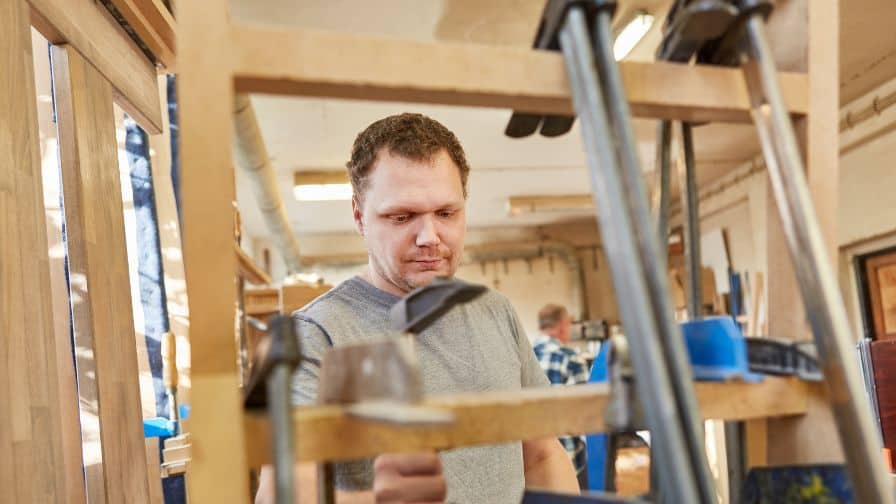
Do you need to hold things together while you’re working on it? If so, then you might wonder whether to use a parallel clamp or pipe clamp. Both of these tools have their pros and cons, and which one is right for you will depend on your individual needs.
In this blog post, we will discuss the differences between parallel clamps and pipe clamps. So that you can make an informed decision about which one is best for you.
Parallel Clamps Vs Pipe Clamps
There are many different types of clamps available on the market today. But two of the most popular and versatile options are parallel clamps and pipe clamps. So, which one is right for your next project?
Let’s take a closer look at the key differences between these two types of clamps to help you make the best decision.
When it comes to woodworking, both parallel clamps and pipe clamps have a lot to offer. Parallel clamps, also known as bar clamps, are the most popular type of clamp for woodworkers. They get their name from the fact that they have two parallel jaws that can adjust to apply pressure to your workpiece from both sides. This makes them ideal for a wide range of applications, including gluing, sanding, and routing.
Pipe clamps, on the other hand, get their name from the fact that they use a length of pipe as the bar between their jaws. This gives them a few advantages over parallel clamps. First, they’re much cheaper to make, which means they’re more affordable for woodworkers. Second, they’re longer than parallel clamps, which makes them better suited for working with larger pieces of wood. Finally, the length of the pipe between the jaws of a pipe clamp makes them more stable than parallel clamps. It is important for ensuring accuracy when working on your project.
If you’re looking for a versatile option that can handle a wide range of projects, then parallel clamps are a wonderful choice!
But if you’re working with larger pieces of wood or you’re looking for a more affordable option, then pipe clamps are the way to go.
No matter which type of clamp you choose, you’ll find that it’s a valuable addition to your woodworking toolkit.
What Are Parallel Clamps?
Parallel clamps are one of the most versatile tools in a woodworker’s arsenal. They can clamp two pieces of wood together for gluing or to hold a workpiece steady while you saw it. Parallel clamps come in a variety of sizes, so you can choose the right size for your project.
What Are Pipe Clamps?
By definition, a pipe clamp is simply a clamp that uses a pipe as its bar. This gives the clamp more reach and leverage than a standard clamp. It’s perfect for everything from holding two pieces of wood together while you glue them to keeping a long pipe from moving while you work on it.
There are two basic types of pipe clamps: the one-handed clamp and the two-handed clamp. Operate the one-handed clamp with one hand. It has a ratcheting mechanism that lets you tighten or loosen the clamp with a few turns. Use the two-handed clamp with two hands. You twist the handle to tighten or loosen the clamp.
Pipe clamps are in a wide range of sizes. For most home workshop projects, you’ll want clamps that are about 18 inches long. But for some jobs like working on a long pipe, you’ll need a clamp that’s several feet long.
If you’re working with wood, you’ll want to get pipe clamps with plastic or rubber jaws. These won’t damage the wood like metal jaws would.
You can find pipe clamps at any hardware store. They’re not very expensive, so get a few sizes and keep them on hand for when you need them.
The Benefits Of Using Parallel Clamps
There are a variety of types of clamps, but one of the most useful is the parallel clamp.
Parallel clamps are advisable for multiple projects, including:
-Gluing boards together
-Attaching boards to a flat surface
-Make sure boards are level with each other
One of the benefits of using parallel clamps is that they suit both small and large projects. Another plus is that they’re inexpensive, so you don’t have to break the bank to get a set. Finally, parallel clamps are easy to use.
Subscribe to WoodWorkers Guild Of America on YouTube
The Benefits Of Using Pipe Clamps
If you’re a do-it-yourselfer, then you know that having the right tools can make all the difference. That’s why we’re big fans of pipe clamps. In case you’re not familiar with them, pipe clamps are long strips of metal or plastic that have jaws on either end. You can use them to clamp things together while you’re working on them.
Pipe clamps are fantastic for three reasons.
First, they’re very versatile. You can use them to clamp wood, metal, plastic, and about anything else.
Second, they’re strong. They can exert a lot of pressure, which is helpful when you’re working with materials that are difficult to hold together.
Third, they’re easy to use. Squeeze the handles together and the jaws will clamp down on whatever you’re trying to hold together.
How To Choose The Right Clamp For Your Needs
There are a few things to keep in mind when selecting the right clamp for your needs. First, consider the size and capacity of the clamp. Clamps come in a variety of sizes, so you’ll need to choose one that can accommodate your material.
Second, think about the amount of pressure you need to apply. Some clamps require more pressure than others. Select one that will work for your project.
Finally, consider the price. Clamps can range in price from a few dollars to hundreds of dollars. Choose one that fits your budget.
With these factors in mind, you should find the perfect clamp for your needs.
Subscribe to Jonathan Katz-Moses on YouTube
Are Parallel Clamps Better Than Pipe Clamps?
There’s no simple answer to this question. It depends on what you’re looking for in a clamp, and what type of projects you use them for.
Here are some things to consider when making your decision:
-Pipe clamps are less expensive than parallel clamps.
-Pipe clamps are easier to set up and use.
-Parallel clamps can apply more pressure than pipe clamps.
-Parallel clamps are more versatile than pipe clamps.
If price is a big factor, then pipe clamps are the way to go. They’re also a good choice if you’re new to woodworking, or don’t do a lot of clamping in your projects. Parallel clamps are more expensive, but they’re worth the investment if you do a lot of clamping or need the extra pressure for tougher projects.

Are Pipe Clamps Good For Woodworking?
There are a lot of diverse opinions out there when it comes to pipe clamps. Some woodworkers think that they are essential for any project, while others believe that they are nothing more than a waste of money. So, what is the truth? Are pipe clamps necessary for woodworking?
The answer to this question depends on the type of woodworker you are. If you enjoy working on small projects, then pipe clamps are optional. On the other hand, if you frequently work on large or complicated projects, then pipe clamps are a valuable addition to your toolkit.
Pipe clamps are most common for glue-ups. They provide even pressure across the entire length of the glue-up, which helps to prevent warping and cupping. Pipe clamps are also useful for clamping odd-shaped pieces of wood together.
Are Pipe Clamps As Good As Bar Clamps?
When it comes to woodworking, there are two main types of clamps: pipe clamps and bar clamps. Each has its own unique set of benefits that make it better suited for certain tasks.
Pipe clamps are for tasks that require long and straight cuts. This is because they have a longer reach than bar clamps and can position easily along the length of a board.
Bar clamps, on the other hand, are better suited for tasks that require more pressure to apply. This is because they have a shorter reach and can apply more pressure per square inch.



